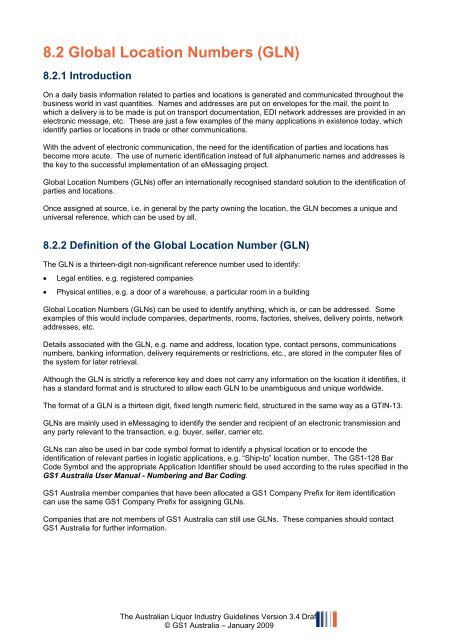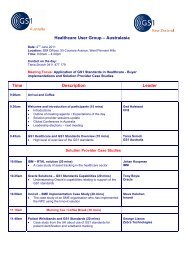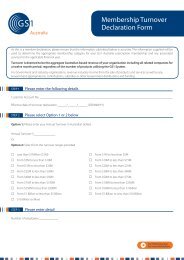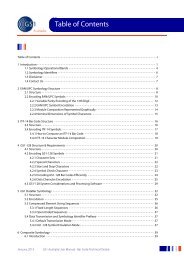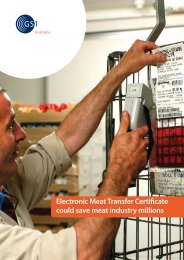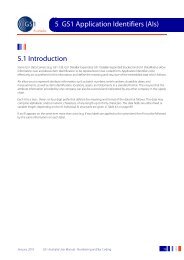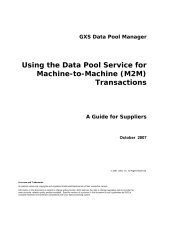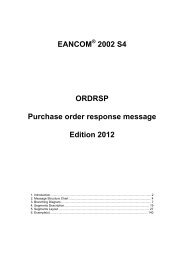Industry Guidelines for the Numbering and Bar ... - GS1 Australia
Industry Guidelines for the Numbering and Bar ... - GS1 Australia
Industry Guidelines for the Numbering and Bar ... - GS1 Australia
Create successful ePaper yourself
Turn your PDF publications into a flip-book with our unique Google optimized e-Paper software.
8.2 Global Location Numbers (GLN)<br />
8.2.1 Introduction<br />
On a daily basis in<strong>for</strong>mation related to parties <strong>and</strong> locations is generated <strong>and</strong> communicated throughout <strong>the</strong><br />
business world in vast quantities. Names <strong>and</strong> addresses are put on envelopes <strong>for</strong> <strong>the</strong> mail, <strong>the</strong> point to<br />
which a delivery is to be made is put on transport documentation, EDI network addresses are provided in an<br />
electronic message, etc. These are just a few examples of <strong>the</strong> many applications in existence today, which<br />
identify parties or locations in trade or o<strong>the</strong>r communications.<br />
With <strong>the</strong> advent of electronic communication, <strong>the</strong> need <strong>for</strong> <strong>the</strong> identification of parties <strong>and</strong> locations has<br />
become more acute. The use of numeric identification instead of full alphanumeric names <strong>and</strong> addresses is<br />
<strong>the</strong> key to <strong>the</strong> successful implementation of an eMessaging project.<br />
Global Location Numbers (GLNs) offer an internationally recognised st<strong>and</strong>ard solution to <strong>the</strong> identification of<br />
parties <strong>and</strong> locations.<br />
Once assigned at source, i.e. in general by <strong>the</strong> party owning <strong>the</strong> location, <strong>the</strong> GLN becomes a unique <strong>and</strong><br />
universal reference, which can be used by all.<br />
8.2.2 Definition of <strong>the</strong> Global Location Number (GLN)<br />
The GLN is a thirteen-digit non-significant reference number used to identify:<br />
• Legal entities, e.g. registered companies<br />
• Physical entities, e.g. a door of a warehouse, a particular room in a building<br />
Global Location Numbers (GLNs) can be used to identify anything, which is, or can be addressed. Some<br />
examples of this would include companies, departments, rooms, factories, shelves, delivery points, network<br />
addresses, etc.<br />
Details associated with <strong>the</strong> GLN, e.g. name <strong>and</strong> address, location type, contact persons, communications<br />
numbers, banking in<strong>for</strong>mation, delivery requirements or restrictions, etc., are stored in <strong>the</strong> computer files of<br />
<strong>the</strong> system <strong>for</strong> later retrieval.<br />
Although <strong>the</strong> GLN is strictly a reference key <strong>and</strong> does not carry any in<strong>for</strong>mation on <strong>the</strong> location it identifies, it<br />
has a st<strong>and</strong>ard <strong>for</strong>mat <strong>and</strong> is structured to allow each GLN to be unambiguous <strong>and</strong> unique worldwide.<br />
The <strong>for</strong>mat of a GLN is a thirteen digit, fixed length numeric field, structured in <strong>the</strong> same way as a GTIN-13.<br />
GLNs are mainly used in eMessaging to identify <strong>the</strong> sender <strong>and</strong> recipient of an electronic transmission <strong>and</strong><br />
any party relevant to <strong>the</strong> transaction, e.g. buyer, seller, carrier etc.<br />
GLNs can also be used in bar code symbol <strong>for</strong>mat to identify a physical location or to encode <strong>the</strong><br />
identification of relevant parties in logistic applications, e.g. “Ship-to” location number. The <strong>GS1</strong>-128 <strong>Bar</strong><br />
Code Symbol <strong>and</strong> <strong>the</strong> appropriate Application Identifier should be used according to <strong>the</strong> rules specified in <strong>the</strong><br />
<strong>GS1</strong> <strong>Australia</strong> User Manual - <strong>Numbering</strong> <strong>and</strong> <strong>Bar</strong> Coding.<br />
<strong>GS1</strong> <strong>Australia</strong> member companies that have been allocated a <strong>GS1</strong> Company Prefix <strong>for</strong> item identification<br />
can use <strong>the</strong> same <strong>GS1</strong> Company Prefix <strong>for</strong> assigning GLNs.<br />
Companies that are not members of <strong>GS1</strong> <strong>Australia</strong> can still use GLNs. These companies should contact<br />
<strong>GS1</strong> <strong>Australia</strong> <strong>for</strong> fur<strong>the</strong>r in<strong>for</strong>mation.<br />
The <strong>Australia</strong>n Liquor <strong>Industry</strong> <strong>Guidelines</strong> Version 3.4 Draft<br />
© <strong>GS1</strong> <strong>Australia</strong> – January 2009


